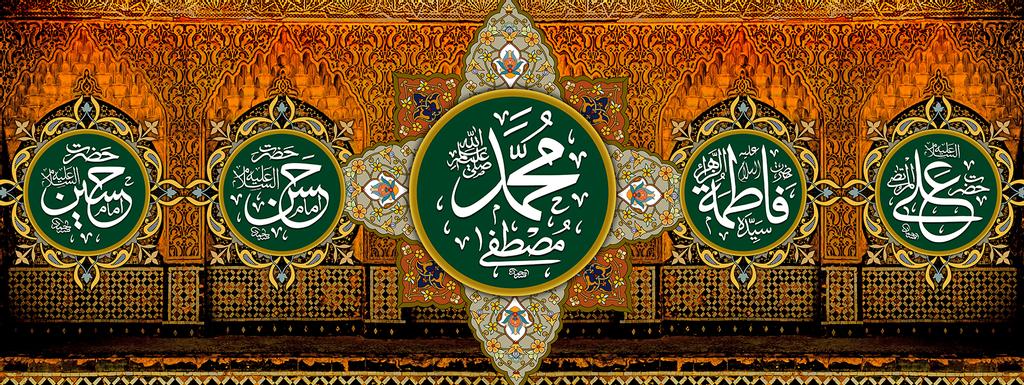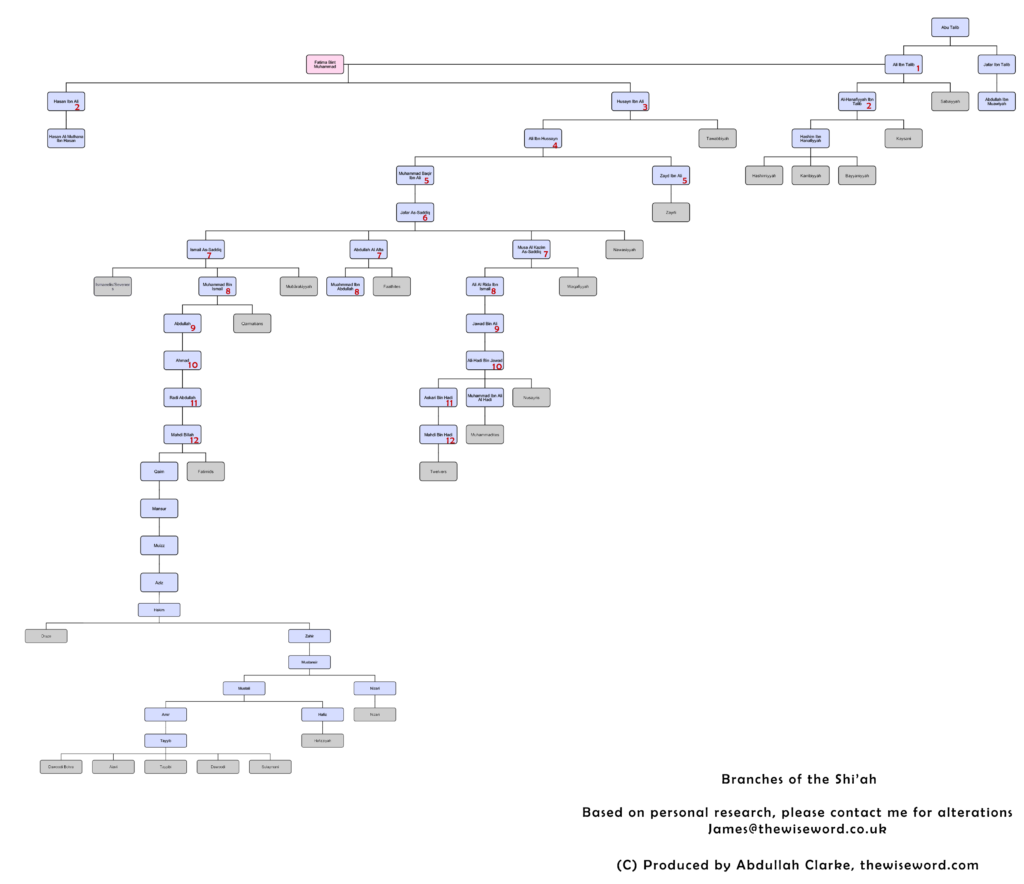A historical analysis on the origins of Shi’ah sects. Shi’ah linguistically means party and were known as the Shi’atul ‘Ali, the Party of Ali. I’ll refer to the mentioned figures by their names or kunya only. May Allah be pleased with all of the family of the Prophet and those who loved them sincerely. You can also find a summarised chart at the bottom of this article.
Brief Background
After the death of the Prophet ﷺ there was a dispute regarding the new successor. A group supported Ali as he was from the family of Prophet, but Abu Bakr was elected as Caliph. Unfortunately animosity remained within these followers. Then it was Umar, then Uthman. Ali was selected as the fourth Caliph, however it wasn’t a smooth ride as the first civil war ensued against the Ummayyad governor Muawiyyah ibn Abi Sufyan. During these wars, Ali was supported (and abandoned) by his party. This behaviour of the Šhi’ah will be seen to be repeated as we go on.
Sunni sources also point to a man called Abdullah ibn Saba who started the movement formally. He was a Jew of Yemeni origin. He began to claim Ali was divine and God incarnate. When Ali heard of this he warned him and his group and commanded them to repent. They failed to do this, so then he punished them by burning them to death, but he did not get to capture ibn Saba personally. When Ali died, Ibn Saba claimed that it was impossible for Ali to die and that it was the devil who died. He said Ali will come back to earth as the Mahdi, this was known as the Al-Raja’, The Return (known as occultation). Such people with such beliefs were known as Saba’iyyah.
After Ali was assassinated he was succeeded by his son Ḥasan. Ḥasan gave up the Caliphate in order to achieve peace with the Ummayads. Muawiyyah was the new leader of the Muslims. When he died, he passed the reign down to his son Yazid. Ḥusayn could not accept a tyrant and open sinner to be the Islamic leader therefore rebelled but was brutally slaughtered alongside his family. The main reason for this was due to the party of the Ahlul Bayt abandoning them at the last minute.
The Shi’ah sects
It was at the demise of Ḥusayn when the Šhi’ah became a distinct group of people. They moved away from Caliphate, and went to Imamate. The idea was that the Imams are from the family of the Prophet, divinely selected and inspired. So Ali became the first Imam, Ḥasan the 2nd and Ḥusayn the 3rd. There was also a split in the Šhi’ah for those who wanted Political Revenge, known as Tawabiyyah and others who wanted Spiritual form. The latter went with Ali ibn Ḥusayn, and he was selected as the 4th Imam. He refused to get in to political warfare with the Tawabiyyah. Theological Shiism also started to spread where there was open hatred of the Sahabi, the concept of Occultation, etc.

The third son of Ali, born to a different woman, was called Al-Hanafiyyah. He was the leader of the political arm of the Šhi’ah and declared the 4th Imam, those who supported him were known as Caseinites. One of his followers was Muqhtar al Thaqafi. He wanted to revolt against the Ummayyads, but never got the full support of Al-Hanfiyyah. Eventually the revolt failed. Al Hanifiyyah dies shortly also.
Then Ali bin Husayn dies, and Al Baqir his son is the new imam, the 5th Imam. However he was challenged by Al-Hanfiyyah’s son Abu Hashim. They were called the Hashimiyyah, but there was also a group of them called the Karribiyyah. They refused to believe Al-Hanafiyyah died, but will return as the Mahdi.
Furthermore, Al Baqir was also challenged by his brother Al Zayid who was rebellious. Zayid even claimed their father, Ali ibn Husayn was not the rightful Imam. During the battle of Karbala, Ali ibn Husayn was ill so did not go out to battle, however his cousin Hasan al Muthana (The son of the 2nd Imam Hasan) went out to fight. Due to this, they say Hasan al Muthana was the 4th Imam rather than Ali ibn Husayn. Followed by Al Zayd, the 5th imam. They felt the Imam needs to be someone who is able to stand up politically and take up arms if they need to. His followers are called the Zaydis.
So there are three leaders, Al Baqir the 5th Imam, Al Zayd the 5th Imam and Abu Hashim the 5th Imam.
Jafar Sadiq, Zayid and Abu Hashim
When Imam Baqir died, his son Jafar Sadiq became the 6th imam. He tried to unify and standardise the Imamate, by claiming that the Imam will converse with God or get inspired and before his death he will declare the new Imam. It is worth noting, Imam Jaafar is well respected amongst the Sunnis. He is also the great great grandson of Abu Bakr and considered a key Shaykh in the Naqshbandi Sufi order. As well as a great scholar of Fiqh, and then mentor of Imam Abu Hanifa. Therefore you will find multiple viewpoints on the true nature of Jafar Sadiq. The Sunni position is that he was strictly adherent of the Shariah and Sunnah, however those around him caused havoc.
Al Zayd was in Kufa now and Ja’far al-Sadiq in Makkah. Al Zayd tried to overtake the Ummayyad Caliph Hisham but was killed. Again the Kufans betrayed him. They wanted him to curse Abu Bakr and Umar but he refused, so as he had no support he was led to his death. Then Abu Hashim tried to revolt, but he died. Multiple people claimed to be the new Imam. The Bayaniyyah believed he did not die but went in to occultation.
One claimant was Abdullah ibn Muawiyah, who was the great grandson of Ja’far al-Sadiq ibn Abi Talib, he claimed to be the 6th imam, a Prophet and a God- head. He led a revolt against Ummayyad’s but was also defeated.
The Abbasids (not yet in power) tried to get the support of the Šhi’ah by claiming the Imamate. Muhammad ibn Ali ibn Abdullah, a descendant of Prophet’s uncle Al Abbas, was put forward. He said Abu Hashim designated him to be the Imam. When he died, it was passed on to his son Abul-Abbas. They were supposedly the 6th and 7th Imams. At this point the Abbasids overtake the Ummayads and Abul-Abbas was the first Abbasid Caliph. They also dropped their claims to Imamate.
The Šhi’ah then revolt in Madina, during reign of Al Mansur, led by Muhammad al Nafs al Zakkiyyah. He was the great grandson of Hasan. He and his brother tried to revolt in Basra but both died.
So there is only one leader, Ja’far al-Sadiq the 6th Imam, and Zayd and Abu Hashim are finished.
Ja’far al-Sadiq Sadiq had designated his son Ismail as the 7th Imam but Ismail died before his father. Then Ja’far al-Sadiq dies but he hadn’t yet designated a new Imam. A party of them said Ja’far al-Sadiq didn’t die but went in to occultation. They were known as Nawasiyyah. His eldest son Abdullah al Afta was supported by another party of them, and known as Faathites. He died only shortly after, but some continued to support his son, Muhammad ibn Abdullah al Aftah declaring him as the 8th Imam. They claimed he was his secret son. When he also died, it was said he has gone in to occultation.
Another party of them supported Musa al Kazim, another son of Ja’far al-Sadiq and the younger brother of Al-Aftah. He would be known as the 7th imam. He managed to get support of the Nawassiyah however some sternly believed, although Ismail has died, he was the 7th Imam since he was selected by his father. They were known as the Ismailis. Ismail was a rebellious son so they felt he had more right to Imamate, they claimed he had gone in to hiding and will return as the Mahdi. They believe the Imamate also stopped here and are also known commonly as the Seveners.
Some said it passed to his son Muhammad ibn Ismail, and he was the 8th Imam. This succession continued. Eventually they are the ones who founded the Fatimid dynasty. They also went in to hiding in the Shaam region, using a system called Dāʿiyyūn to convert people.
The Twelvers Shi’ah
Under Musa al Kazim there was much Šhi’ah persecution and Musa was in prison several times where he eventually died. Some believed he will return as the Mahdi so taken in to occultation. They were called the Waqafiyyah. He chose his son Ali al Rida as the 8th Imam. Ali managed to unite with the Waqafiyyah. He was asked by Al Mamun, a leader of the opposition during the Abbasid Civil war, to meet him. He told Ali that he will choose him as his successor. But Ali died on the way home. His son Al Jawad succeeds him as the 9th Imam but was only 8 years old.
The doctrine of ilm is introduced here, where the Šhi’ah believe when one becomes Imam, all spiritual knowledge is handed down too. Al Mamun, in order to show his keenness, married his daughter to Al Jawad. Jawad then also died, and was most likely poisoned by Al Mamuns brother. His son Al Hadi becomes the 10th Imam. Al Hadi was imprisoned and died leaving behind a 2 year old Al Askari. The Šhi’ah elders were not keen on making him the 11th Imam as he was only a toddler. However Uthman al Amri supported him.
During the Imamate of Ja’far al-Sadiq, agents were set up to bring people to Shiism and collect a fund to support the Imamate. The agents also got paid from this pot. Uthman al Amri was the head agent, so it was in his interest to continue this, the Šhi’ah elders accepted Al Askari as the 11th Imaam.
Al Askari died leaving no children behind, however Uthman al Amri claimed he had a child with a slave girl and named him Mahdi. The boy was taken in to occultation. Uthman al Amri continued the leadership of the Šhi’ah on behalf of the Mahdi, followed by his son Abu Jafar, then al Nawbaqthi, then Hasan al Samarri. Hasan claimed the final message from the Mahdi was that do not nominate anyone anymore.. and that he the Mahdi will return when Allah wills. The followers of the 12 Imams are called the Imamiyyah, or commonly known as the Twelvers.
After this called the leaders are called Al Waqil, the representatives. or in Modern day twelver Shiism, the Ayatollah.
There are many other smaller sects that appear further down the line, especially in the Ismaili chain. Have a look at the chart below.
Modern Day Shiism
Šhi’ah’s are present in all countries. The Twelver branch being the largest with followers Iran, Azerbaijan, Iraq, and Bahrain. The Zaidis are mainly in Yemen and Ismailis across Central Asia and Afghanistan. However there are Šhi’ah across most of the world.


